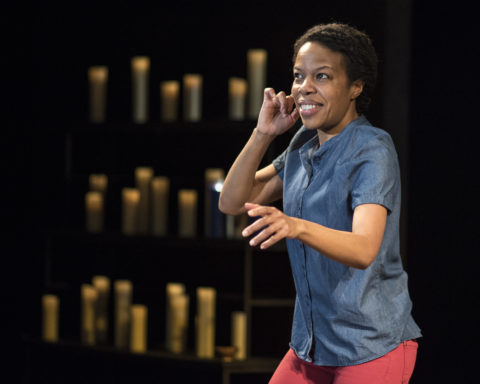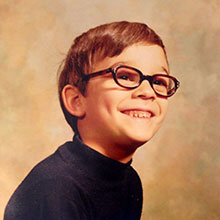 Like the Cirque that shares her surname, Nilaja Sun dazzles audiences with jawdropping skills while demonstrating considerably less knack for conveying a storyline.
Like the Cirque that shares her surname, Nilaja Sun dazzles audiences with jawdropping skills while demonstrating considerably less knack for conveying a storyline.
Sun plays four men and five women in her fast-paced, always entertaining solo show, “Pike St.”, now at the Berkeley Rep. Her characters converge in and around the Lower East Side tenement apartment called home by three generations of the Vega family.
At the center of this clan is Evelyn, the effortfully upbeat single mother of a seriously disabled teenage daughter, Candi.
Evelyn’s libidinous widowed father, referred to only as Papi, lives here too. And her brother, Manny, an enlisted soldier returns home from Afghanistan on the day the play is set. The spiritual essence of the family’s late matriarch is also conjured in opening and closing moments.
Sun swiftly etches her characters, using powerful physical and verbal shorthand to make each of them indelibly distinct. Plainspoken Evelyn holds her head high. Candi has twisted limbs and a slack jaw. Papi is stoop-shouldered and broad-stanced with a protruding lower lip and a thick Puerto Rican accent, frequently used to deliver racy wisecracks. Manny speaks minimally, holding himself at constant attention to tamp down the rage and disorientation of PTSD.
Beyond the family, Sun gives us Manny’s squinty, skulking hoodrat pal Ty; Papi’s money-hungry ladyfriend Migdalia; a Yemeni bodega owner; and gabby downstairs neighbor Mrs. Applebaum, whose osteoporotic gait and Yiddish inflection, while undeniably funny are also unquestionably stereotypical. Like Papi’s horny old goat schtick, Mrs. Applebaum’s dialogue finds Sun leaning hard on ethnic caricature.
That’s an almost inevitable pitfall of Sun’s hyper-kinetic performance style. She’s not doing a series of monologues here: Two, three, even four characters at a time engage in often rapid-fire dialogue. And even her minor roles must be instantly recognizable. Imagine each character as a television station with Sun pressing her thumb down on the channel changer: The transitions come impressively fast, but along with PBS, HBO, Telemundo and BET, the Cartoon Network gets its moments. Oy!
Sun’s transitions and the show’s occasional changes in locale are elegantly supported by director Ron Russell’s space-carving sound design and and Tyler Micoleau’s lighting, which subtly cues each character shift. But as dazzling as Sun’s transformations are—and they’re dazzling enough to make “Pike St.” well-worth seeing—the show’s writing and conceptual constructs detract from its strengths. In choosing to juggle so many characters throughout an 80 minute show, Sun gives herself little choice but to portray some of more sketchily than others. Depth sometimes takes a backseat to flash, with some genuinely touching moments that deserve room to breathe abruptly shifting to more jokey material.
One wonders how much more emotionally impactful “Pike St.” might be if Sun reduced her character-palette to the members of the Vega family, allowing their impact on one another’s lives to become clearer and more nuanced. We get plenty of recognizable tics, but not enough sense of what makes each character tick.
The link between overpopulation and underwriting is most sharply underscored in Sun’s efforts to provide audiences with not only a portrait gallery, but a multi-tentacled plot. The action of “Pike St.” takes place on a day when not only is Manny returning from Afghanistan, but New York is bracing for the onslaught of a major hurricane. The storm poses particular danger to Candi, who is dependent on electric power to run her respirator and dialysis machine. Oh, and Manny needs to be told that the business he planned to run—his late mother’s botanica—has been shuttered and sold during his final tour of duty.
That’s enough literal sturm, family drang and dashed American dream for a lengthy two-act evening, but after being touched upon in the opening scenes of “Pike St.”, they’re essentially set aside for the mesmerizing spectacle of Sun’s characterization skills. When these big themes swoop back in minutes before show’s end they serve more as distraction than denouement.
It’s like an August Wilson drama butting into “Tracey Ullman’s Show.”
